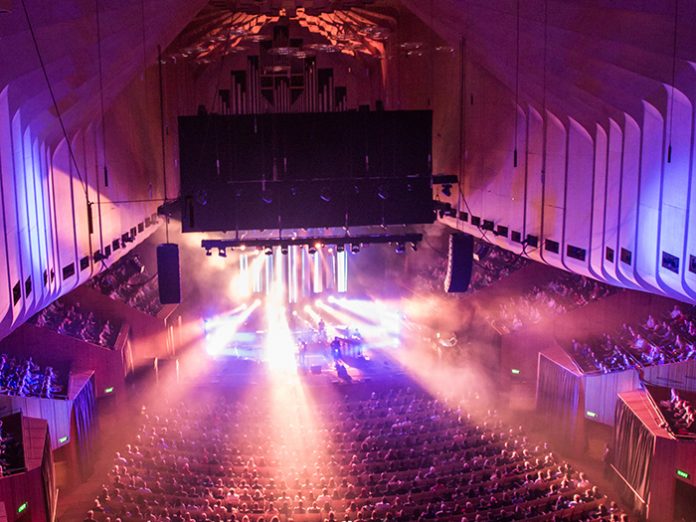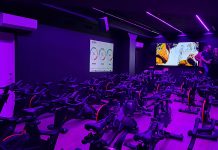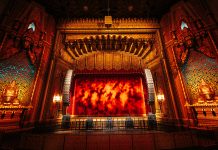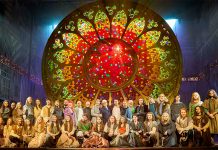Since its inception seven years ago, Vivid LIVE at Sydney Opera House (SOH) has always pushed the boundaries, whether in performance style, musical content, or the support structures that underpin it. So when Jeremy Christian, Head of Sound and AV at the SOH suggested to the festival curator Ben Marshall that he wanted to implement a new piece of control software from d&b audiotechnik, Marshall said, “I’m all for it.”
“It was good timing for us,” said Jeremy. “Pushing the boundaries is about trying something new, and Vivid LIVE offers a really broad spectrum of contemporary musical content against which to make a judgement on effectiveness and utility. It’s easy to assess something as great, but how easy and useful it is to apply is what really matters. When we came to implement d&b’s ArrayProcessing we already knew of its potential from our experience at a d&b event in Germany at the start of the year. Downstream of the festival we have realised there are capabilities within ArrayProcessing way outside our original expectations, and that could have significant benefits for SOH and for our audiences in the future.”
Ralf Zuleeg who heads up d&b’s Sales Services and Application Engineering department, went out to Sydney just prior to the festival. “I have a long association with SOH; they have been d&b users for many years now, so it was natural I should be there. But of course Jeremy’s team is more than proficient technically, as you would expect in such a prestigious venue. In fact when it came to it, as we started work in the Concert Hall, it was almost a competition between them and me to see what results we could achieve.”
In a nutshell ArrayProcessing enables the unification of frequency response in the vertical plane across the whole defined listening area for d&b line arrays. “ArrayProcessing does not eliminate the need for a system to be correctly rigged in the first place,” said Ralf. “This is not beam steering – so you map your room in the ArrayCalc simulation software as normal; and of course as we all know, you cannot correct for the horizontal coverage of any line array beyond the physical aim of the loudspeaker system as rigged; that would defy physics. ArrayProcessing also allows for the reallocation of energy from any part of the listening area, to any other part, within the confines of mechanical pre-given vertical coverage.”
What does that mean in real terms? The Concert Hall is quite a lively room, though with the drapes canopy added this dampens the natural acoustic. That said, the consensus opinion of the Concert Hall audio team was that following the implementation of ArrayProcessing the improvements in the direct to diffuse ratio were so good, and the reallocation of sound energy to the more distant listening positions so effective, that delay loudspeakers became completely redundant.
That has several implications for Jeremy, as he explained. “We were originally just going to apply ArrayProcessing in the Concert Hall, but we were so impressed with the improvements we decided to do the same in the Joan Sutherland Theatre (JST) as well for the duration of the festival. The JST is home to our opera productions and doesn’t have a permanent large scale sound reinforcement system like the Concert Hall, so we installed a temporary system of d&b V-Series, the smaller cousin to J-Series, which we rented in from Eighth Day Sound Australia. They’re a new player in the Australian market; we don’t favour any specific audio production company – as long as we find d&b equipment to be well maintained and consistent our decision is based simply on price and availability. That said, implementing ArrayProcessing means using d&b’s new D80 amplifier to drive everything, and that’s predicated on one amplifier channel per cabinet, so although many d&b products are passively crossed and only require one channel per box, the gains with which we are familiar in linking two V-TOPs together on one channel are lost. The fact that ArrayProcessing means we no longer need to deploy delays in either of our main performance venues is highly significant, and the truth is we can easily see places where we can usefully redeploy our delay loudspeakers elsewhere in the building.” he continued
“We have had the J-Series system in the Concert Hall for a few years now and are really happy with it, but this is rather like Formula One racing, once you get to that level of technical expertise the differences are measured in thousands of a second. So ArrayProcessing has added one of those incremental gains that make the system even more amazing. Although Vivid LIVE was a temporary installation we already see some great opportunities ahead; in the JST we have experimented for several years now with 3D sound. Based on what we know already it’s easy to see how the addition of ArrayProcessing could impact the listening experience.
“In the Concert Hall we are thinking about something equally radical. It’s important to cater to the varying needs of our patrons; for example some choose seating positions based on sightlines, others on proximity to stage. The point is listeners by nature have differing sensitivity to sound levels; don’t forget it’s not just rock concerts where we use sound reinforcement, a jazz recital averaging 94dBA slow could still be too loud for some. But with ArrayProcessing we have a very realistic prospect of sculpting out a quieter zone within the audience listening area. Patrons could preselect seats in that area; now that really is listening à la carte.”






